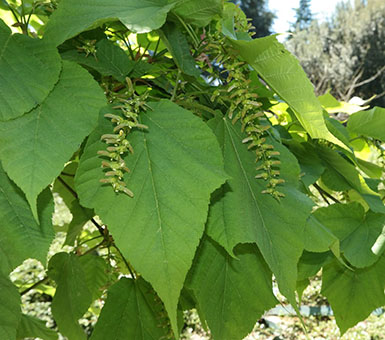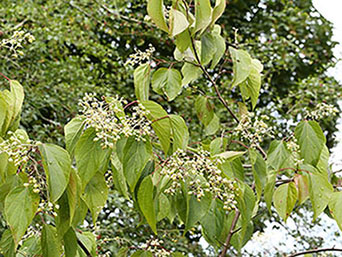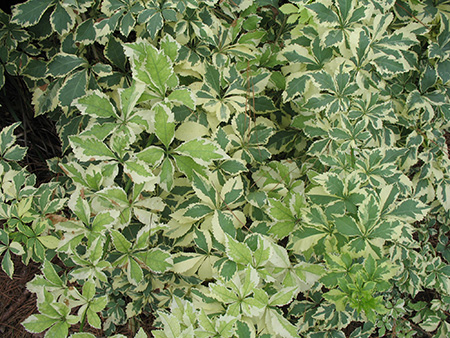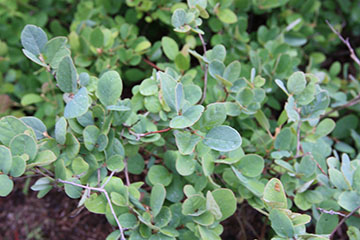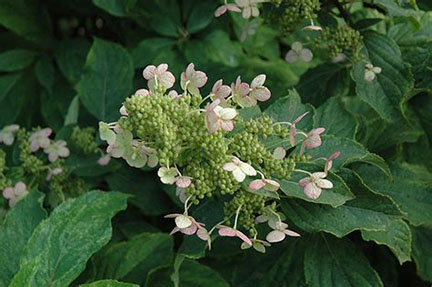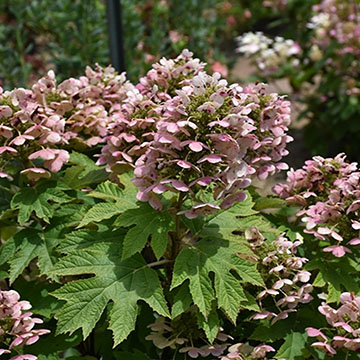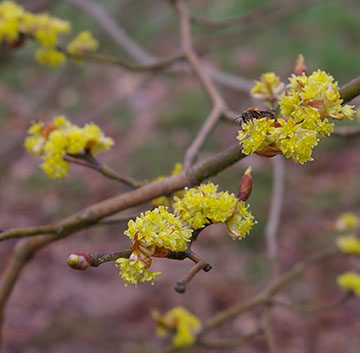Autumn 2024 Newsletter
| Trees Available at the Nursery | Shrubs Available at the Nursery |
| Vines Available at the Nursery | Ferns Available at the Nursery |
| Grasses Available at the Nursery |
Some of Warren's Favorite Trees, Shrubs, and Other Plants - Now Available At the Nursery
Anyone who has met Warren Leach and talked with him about the gardens at Tranquil Lake Nursery knows that plants are his passion. He has spent 39 creating the gardens at the nursery, where many of his favorite plants have found a home. As we wind down container sales at the nursery, we still have a limited, but choice selection of some of Warren's favorite trees and shrubs. Most are in containers -- some others are in the ground, but could be dug. Going through the nursery today, here are just some of the plants for which he has been singing the praises.
| TREES AVAILABLE AT THE NURSERY | |
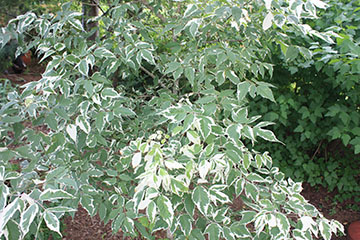 |
Acer negundo ‘Flamingo’, the Flamingo Boxelder Maple is a striking, colorful foliage form of the native box elder. It has received the Award of Merit by the Royal Boskoop Horticultural Society and the Award of Garden Merit by England’s Royal Horticultural Society. It is rather meritorious recognition for a humble tree often found growing in hardscrabble conditions. Despite this, Acer negundo ‘Flamingo’ is still quite scarce.
Flamingo’s first flush of spring leaves unfurl as an atypical coloring of pink and white. The pinnately compound leaves mature to green and white variegation with a hint of pink in the new terminal growth. The compound leaves often sport white, albino leaflets add an exotic, tropical tint. When grown in full sun the petioles are pink. It is a small tree that will flourish in sun or shade. It is easily pollarded to reduce its stature. This hard pruning promotes colorful flushes of pink growth in the summer.
(5 Gallon Containers - $162.) (7 Gallon container - $200.) |
Acer negundo 'Flamingo' |
|
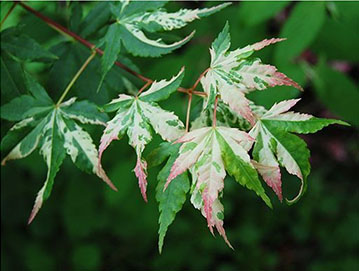 |
Acer palmatum ‘Harriet Waldman' is a variegated foliaged Japanese maple that reaches ten to fifteen feet tall and eight to twelve feet wide at maturity. New leaves start out producing a three colored foliage of green, white, and pink. New growth in late summer makes it look from a distance like it is covered in pink flowers. Plant in dappled shade in average, well-drained soil. Mulch to shield from summer heat. A seedling of Acer palmatum 'Orodono Nishiki' discovered by Phil Waldman of Roslyn Nursery. Zone 5 to 8. (3 Gallon container - $90.) |
| Acer palmatum 'Harriet Waldman' | |
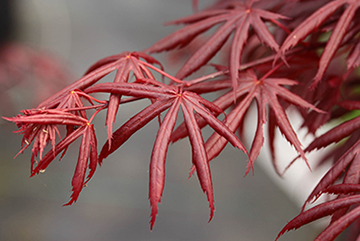 |
Acer palmatum 'Trompenburg' is a small upright
Japanese Maple tree that typically rises to fifteen-to-eighteen feet tall over ten years, eventually maturing to twenty five feet tall. Palmate leaves, seven-to-nine inches long, are deeply cut and serrated, emerge dark reddish purple with good color retention till late summer, when they fade to reddish green and bronze - and then crimson red for fall color. Red leaf stalks. Plant in full sun to part shade in moist, organically rich, slightly-acid, well-drained soil. Prefers afternoon shade. Protect from strong winds. Keep pruning to a minimum. Zone 5 to 8. (3 Gallon container - $90.) |
| Acer palmatum 'Trompenburg' | |
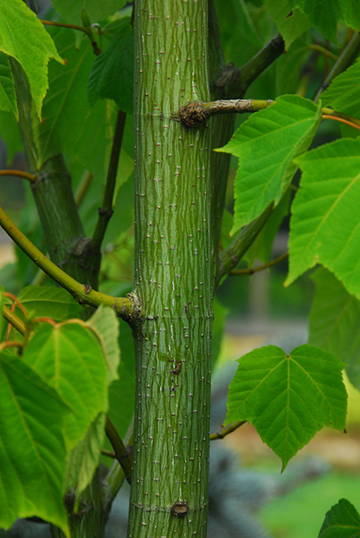 |
Acer pensylvanicum commonly known as snakebark maple or Moosewood is a shrubby understory maple that is native to moist, rocky forests from Wisconsin to Quebec and south in the Appalachians to Georgia. It typically grows as a large shrub or small tree to fifteen to twenty-five feet tall (less frequently to forty feet tall) with a rounded but uneven crown that is sometimes flat-topped. This is the only species of snakebark maple that is native to North America. Key ornamental features are its interesting bark and fall color. Greenish bark on young branches and young trunks is vertically marked with distinctive white stripes (hence the common names of snakebark maple and striped maple). Stripes may vanish over time as older bark turns reddish brown.
Obovate, double-serrulate, three-lobed leaves (to seven inches long) emerge with pink hues in spring, mature to dark green by summer and turn bright yellow in fall. Leaf purportedly resembles a goose foot, hence the common name of goosefoot maple for this plant. Small yellow flowers (1/3” diameter) bloom in pendant racemes (to six inches long) in spring (May). Flowers give way to winged samaras (to one inch long). Moose and white tailed deer often browse the leaves and young twigs hence the common name of moosewood. Whistles can easily be carved from branch sections, hence the common name of whistlewood. Easily grown in average, medium moisture, well-drained soils in part shade. Excellent shade tolerance. Plants dislike full sun conditions. Slightly acidic, consistently moist soils are preferred. Best performance occurs in cool summer climates. Zone 3 to 7. (2 Gallon container - $32) |
| Acer pensylvanicum Moosewood | |
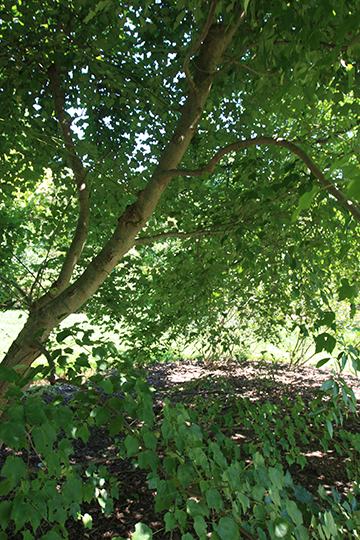 |
Acer rubrum 'Weepy' (Pendulous Red Maple)
This weeping red maple selection was found as a chance variation by horticulturist Clarence Towe, author of American Azaleas. It has a rounded habit and weeping branches. The foliage is typical to other red maples, with good red fall color. Should reach a mature height of twenty feet. Wayne Mezitt of Weston Nursery in Hopkinton acquired this rare weeping maple form, and gave one to Warren. We have been propagating it through cuttings. Plant in full sun in average to moist well drained soil. Zone 4 to 8. (3 Gallon containers - $86.) |
| Acer rubrum 'Weepy' | |
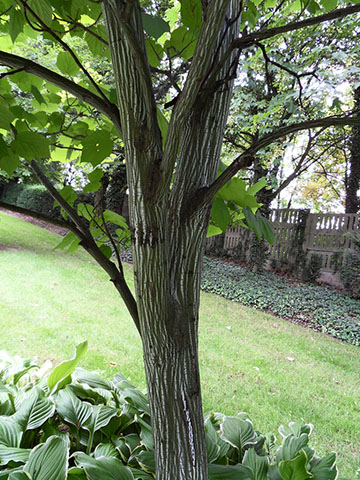 |
Acer tegmentosum, the Manchurian Striped Maple is one of the most beautiful snake-bark maples with magnificent jade and silver striated bark, complimented in winter by striking mahogany colored buds. Lush, large green leaves in summer turn nice shades of butter yellow in autumn. Mature height to twenty feet. A stunning maple year round. Prefers part shade and some shelter from wind. Native to mountainous regions of Manchuria and North Korea. Zone 5 to 8. (5 Gallon container - $100.)
|
| Acer tegmentosum | |
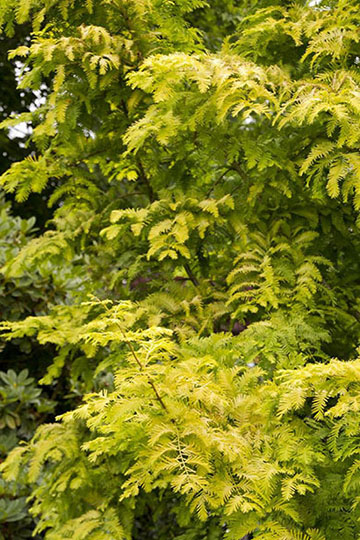 |
Metasequoia glyptostroboides ‘Gold Rush’ is a cultivar of Dawn Redwood that features soft, linear, feathery, fern-like foliage that is distinctly golden-yellow throughout the summer. Foliage gradually turns orange-brown in fall. Grows somewhat slower that the species. Trees will typically rise to ten to fifteen tall over the first ten years, eventually maturing to seventy to hundred feet tall. Prefers moist well, drained soil in full sun. Zone 4 - 8 ( 5 Gallon Container - $90.) (10 Gallon Container - $150.)
|
| Metasequoia glyptostroboides 'Gold Rush' | |
| Pinus densiflorus 'Pendula' | Pinus densiflorus 'Pendula' is a weeping form of Japanese Red Pine that has been grafted to a standard with branches weeping downward. It may also be draped over a wall with branches weeping downward from the point of the graft or draped over a wall with branches cascading downward. Mature shape and height depend upon how the plant is grown. Typically grows three-to-five feet tall over the first ten years. Dark green needles in bundles of two (to four inches long). Bark matures to gray-fissured at the base. Oval to oblong cones (to two inches long). Needles may yellow in winter. Plant in full sun in average, well-drained soil. Tolerates some afternoon sun. Deer resistant. Zone 4 to 7. (3 Gallon container - $50.) |
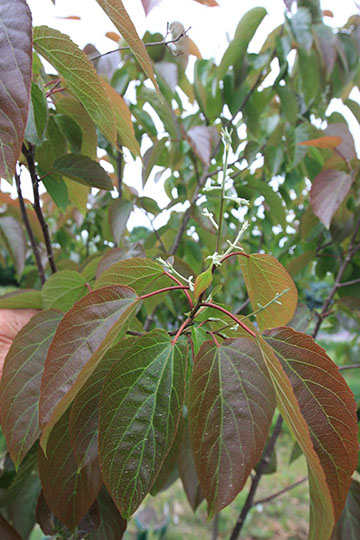 |
Poliothyrsis sinensis, known as the Chinese Pearlbloom produces large, ovate leaves that emerge in spring flushed with iridescent burgundy overtones, then age to rich, glossy green by early summer, then turn yellow in fall. By August, plants are cloaked with a wonderful display of finely textured, creamy-white, terminal flower panicles on red stems, that look like pearly buds and are fragrant. A rarely seen small tree to twenty-to-forty feet in height. Collected in China by E.H. Wilson in 1908. Plant in full sun to partial shade in well-drained soil. Zone 6 to 9. (7 Gallon container - $175.)
|
Poliothrysis sinensis |
|
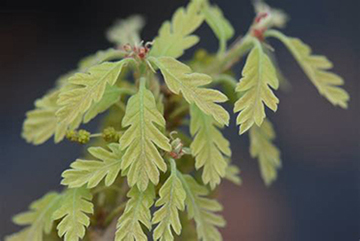 |
|
| Quercus 'Jack Maze' | |
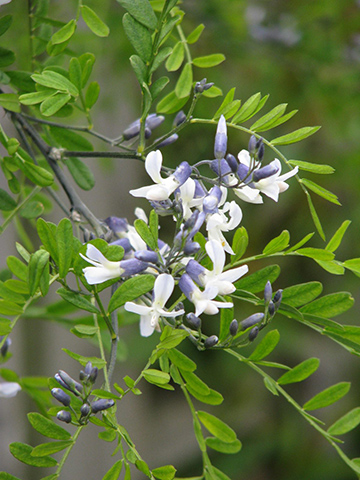 |
Sophora davidii, known as David's Mountain Laurel or Shrub Pagoda Tree, is a spiny, multi-stemmed, deciduous shrub that is native to southwestern China. It typically grows to six to eight feet tall. Pinnate compound leaves (to four inches long), each with eleven to nineteen small elliptic blue-green leaflets (to 3/8" long), are attractive throughout the growing season. Small, fragrant, pea-like, pale blue/white flowers in six inch terminal racemes (six to twelve flowers each) bloom in late spring. Flowers give way to seed pods (one to four seeds each) that mature to brown. Older wood is moderately spiny. Synonymous with and formerly known as Sophora viciifolia. This shrub was discovered growing in western China during the period of 1862-1874 by Jean Pierre Armand David (1826-1900), Jesuit missionary. Best grown in rich, medium moisture, well-drained sandy loams in full sun to part shade. Best in full sun. Once established, plants are tolerant of heat and some drought. Zone 6 to 9. (2 Gallon containers - $48.) |
| Sophora davidii | |
| SHRUBS AVAILABLE AT THE NURSERY | |
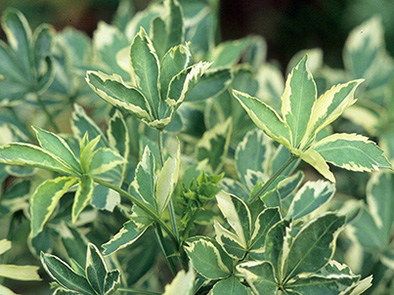 |
Acanthopanax sielboldiana ‘Variegata’, the Variegated Five-Fingered Aralia, is an upright, arching deciduous shrub that reaches six-to-eight feet in height. Striking variegated foliage in which the palmate leaflets are bright green edged with white. Small, greenish white flowers in spring, may give way to black berries on female plants. Plant in full sun to shade. Arching branches are thorny at leaf nodes. Tolerates a wide range of soils. Drought and pollution tolerant. Zone 4 to 9 (2 Gallon container - $34.)
|
| Acanthopanax (Eleutherococcus) sieboldianus 'Variegatus' | |
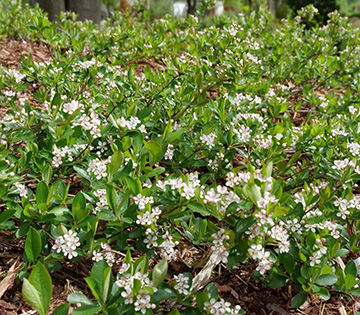 |
Aronia melanocarpa ‘Ground Hug’ - The Ground Hug Black Chokeberry is known for its striking fall color and purple berries that persist into the winter. A flurry of dainty white flowers in spring. This super tough native shrubs grows as a dense ground cover, to one to one and a half foot tall and two-to-three feet wide. It is drought, heat and salt tolerant and attractive to pollinators. An ideal ground cover for parking lots beds, along the driveway, slopes and anywhere difficult to mow. Plant in full sun to part shade in well-drained soil. Zone 3 to 9 (3 Gallon container - $56.) |
| Aronia melanocarpa 'Ground Hug' (Ground Hug Black Chokeberry) | |
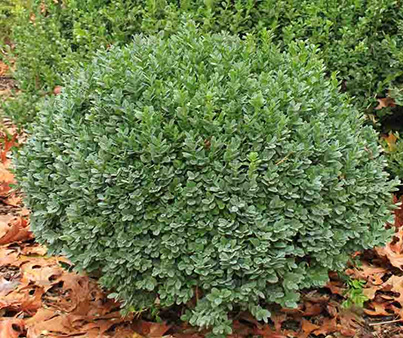 |
Buxus sinica var. insularis ‘Justin Browers’ - This
Dwarf Korean Boxwood is small, with dark green, glossy leaves maintain their color year round, unlike many boxwoods that tend to bronze in winter. Responds well to shearing and is attractive as an individual specimen or part of a manicured hedge or border. A compact, mounding to rounded cultivar. Slow growth rate; ten year size is two-to-three feet tall and wide. Grows well in partial shade to full sun, tolerated dry conditions and shows some deer resistance.
Zone 4 to 8 (One Gallon container - $18. - 2 Gallon containers $32.) |
| Buxus sinica var. insularis 'Justin Brouwers' (Dwarf Korean Boxwood) | |
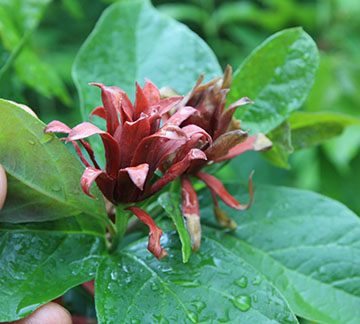 |
Calycanthus floridus, also known as the Carolina Allspice or Sweetshrub, is a dense, rounded deciduous shrub grows to six-to-nine feet tall with an equal or slightly greater spread. Features very fragrant (hints of strawberry pineapple and banana), brown to reddish-brown flowers (two inches across) which bloom at the end of short branchlets in May. Flowers give way to brownish, urn-shaped fruits which mature in the fall and persist through the winter. Lustrous, dark green foliage (pale beneath) turn golden yellow in fall. Site in full sun to part shade in average garden soil. Tends to sucker. Deer Resistant. Native. Zone 4 to 9. (3 Gallon container - $48.) |
| Calycanthus floridus | |
Corylopsis veitchiana This winter hazel is a showy, fragrant addition to the winter garden with primrose yellow, 3" pendant flowers set off by reddish anthers. Blooms in March on bare branches and then produces foliage that starts off bronzy and turns green, with glabrous undersides. Site in a location protected from late spring frosts. Matures at 8' tall and 6' wide. Plant in full sun to part shade in well-drained, slightly acidic soil. Deer resistant. Zone 5-6 to 8 $58.00 |
|
| Corylopsis veitchiana | |
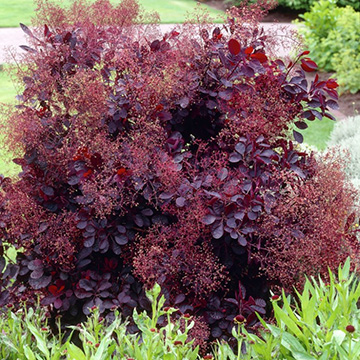 |
Cotinus coggygria ‘Royal Purple’ is a compact smokebush cultivar that typically grows six to eight feet tall and six feet wide. Produces dense, cone-shaped, exceptionally large (to twelve inches) panicles of mostly sterile flowers that emerge white but mature to pink. New flowers continue to emerge at the tip creating a two-toned effect. Strong stiff stems with no drooping. Plant in organically rich, medium moisture, well-drained soil in full sun to part shade. Prune after bloom. Blooms on current year’s wood. Zone 3 - 8 (2 Gallon container - $32) |
| Cotinus coggygria 'Royal Purple | |
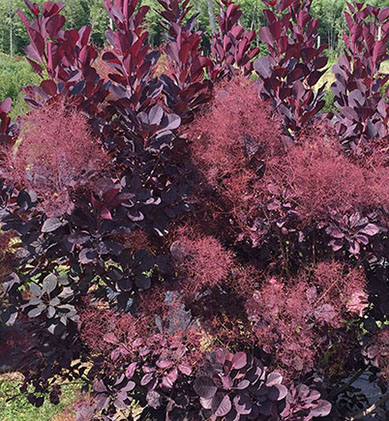 |
Cotinus coggygria 'WineCraft Black' is a Smokebush with round leaves that emerge rich purple in spring. As summer heats up, they turn a deep, near-black tone and finally light up in an array or reds and oranges in fall. Large, soft panicles of smoky pink-red flowers bloom in early summer. Habit is rounded and dwarf reaching forty-eight-to-seventy two inches. Plant in full sun in well drained soil. Prune in spring, if needed, at the expense of smoke for that year. Zone 4 - 8 (3 Gallon container - $52.) |
| Cotinus coggygria 'WineCraft Black' | |
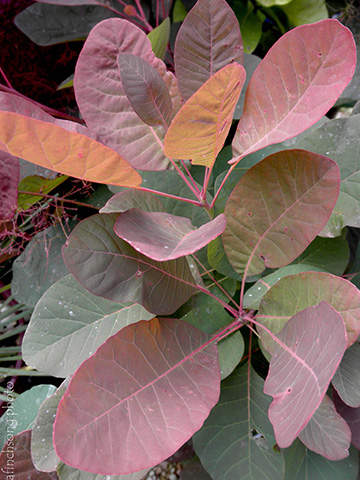 |
Cotinus x ‘Grace’ is a hybrid of the European smoketree ‘Velvet Cloak’ and our native Cotinus obovatis. It is a fast grower with iridescent spring foliage that is green overlaid with red, followed by large burgundy leaves and massive fourteen inches bright pink clouds of blooms (smoke) in June and July. Brilliant autumn foliage that ranges from luminous reddish-purple, to orange and yellow. Can grow to fifteen feet tall and wide. Control size by pruning. Plant in full sun in average, well-drained soil. Winter hardy in containers. Zone 4 to 8. (2 Gallon container - $36.) |
| Cotinus x 'Grace' | |
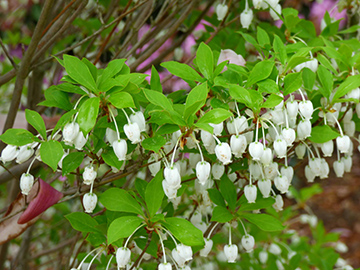 |
Enkianthus perulatus, commonly called white enkianthus, is a compact, slow-growing deciduous shrub that typically grows to six feet tall with a similar spread. It is native to sunny woodland areas of Japan. Urn-shaped, lantern-like, snowy white flowers (1/3” long) in drooping clusters bloom in April to early May (slightly before or at the time of leaf emergence) in nodding, umbel-like, three to ten flowered racemes on wood from the prior year. Individual flowers resemble those of pieris which is in the same family (heath). Young shoots are shiny red (twigs are reddish-brown). Ovate, serrate, medium to bright green leaves have downy midribs on the undersides. Leaves are clustered at the branch tips. Upright seed capsules. Fall color is an often stunning yellow to orange to scarlet red. Easily grown in average, medium moisture, well-drained, acidic soils in full sun to part shade. Best with a moist, organically rich, peaty, lime-free soil that is rich in humus. Blooms on the previous year’s growth, so any pruning should be done immediately after flowering. Zone 6 to 8. (2 Gallon containers - $65.) |
| Enkiantus perulatus | |
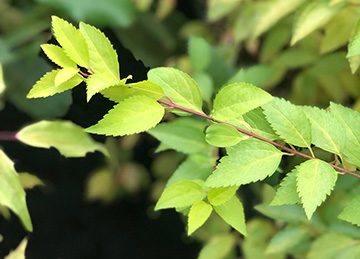 |
Forsythia x intermedia ‘Gold Leaf’ is a Golden Border Forsythia with leaves that emerge lime green in spring, but mature to golden yellow and remain attractive through the season. Light yellow flowers in early spring before and with the first leaves. A spreading, mounding shrub which grows to three-to-five foot tall and wide. Best gold leaf color in part shade. Medium moisture garden soil preferred, but tolerates poor soil. Prune after spring flowering. Zone 5 to 9. (Five pint container - $20.)
|
| Forsythia x intermedia 'Gold Leaf' | |
 |
Fothergilla gardenii ‘Blue Elf’, the Blue Elf Dwarf Witch Elder, is a hybrid between Fothergilla gardenii 'Blue Mist' & Fothergilla gardenii 'Harold Epstein'. The former is a compact, blue foliaged form introduced by the Morris Arboretum in Philadelphia. 'Harold Epstein' is a very dwarf gem from Harold's Larchmont garden in New York. 'Blue Elf ' features the blue foliage of 'Blue Mist', with an intermediate size between the two parents. Fragrant, white, bottle-brush-like flowers in early spring and orange fall foliage color. Plant in full sun to part shade in moist, organically rich, well-drained soil. Native to southeastern US. Zone 5 to 8. (2 Gallon containers - $50.)
Selected and named by Warren Leach for Tranquil Lake Nursery.
|
Fothergilla 'Blue Elf' |
|
Hippophae rhamnoides ‘Sprite’ is a male clone and dwarf selection of seabuckthorn. It is a tough, drought, wind and salt tolerant shrub. Seabuckthorn sports nitrogen fixing nodules on its roots which allows it to thrive in infertile sandy soils. This male selection is unable to produce seed and become a pest. It naturalizes by root suckers. Its rugged constitution accompanies attractive silvery, willow-like foliage. Sprite’s lustrous silver leaves are a superlative foil for the blue flowers of Russian sage (Perovskia atriplicifolia) or the dark purple leaves of smokebush (Cotinus coggygria ‘Royal Purple’). Hippophae rhamnoides ‘Sprite’ has leaves that emerge in early spring, and are a display from March until late December. Zone 4 to 8.
This is one of Warren's favorite plants for the really tough dry conditions such as banks and side walk hell strips. No longer available in nurseries, Warren has this plant propagated every year just for use by Tranquil Lake Nursery. (Five Pint containers - $26.)
|
|
Hippophae rhamnoides 'Sprite' |
|
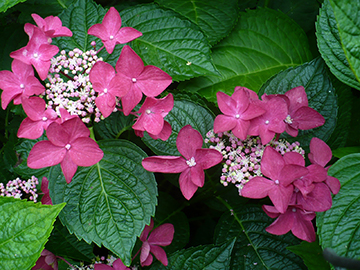 |
Hydrangea macrophylla ‘Lady in Red’
The Lady in Red Lacecap Hydrangea produces Lacecap flowers that appear in early summer, opening pinkish white and maturing to a lush burgundy-rose color. Remarkably beautiful throughout the growing season. Dark red stems and leaf veins complement the lush green foliage, and then turn reddish-maroon in the fall. A rounded, deciduous shrub with sturdy stems to three-to-five feet tall and wide. Mildew resistant. Plant in partial sun in well-drained garden soil. Zone 6 to 9. (2 Gallon container - $36.) |
| Hydrangea macrophylla 'Lady in Red' | |
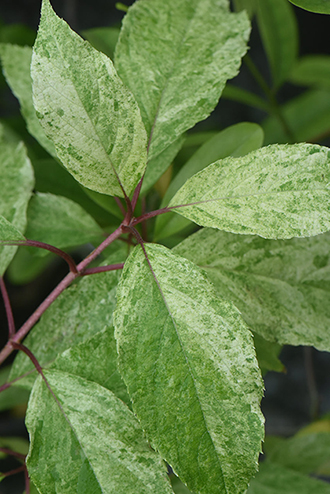 |
Hydrangea paniculata 'Yuki Gessho' is also known as Variegated Panicle Hydrangea. It is a striking clone of Pee Hydrangea that features highly stippled and splashed, creamy white marbled foliage. Red petioles add to the illumination. Typical white, domed flowers in midsummer become pink tinted as they age, drying to brown in autumn. Reaches a height of six-to-eight feet tall and wide. Best grown in bright, lightly shaded location in average garden soil that is well drained. Also known as 'Yukigeshou'. Deer resistant. Zone 3 to 8. (7 Gallon containers - $60.)
|
| Hydrangea paniculata 'Yuki Gessho' | |
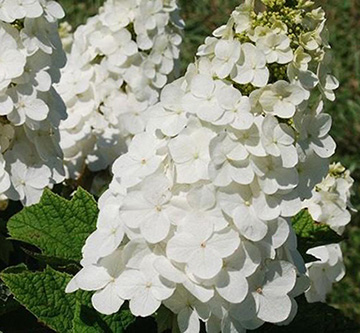 |
Hydrangea quercifolia ‘Queen of Hearts’ is a form of Oakleaf Hydrangea that typically matures in a rounded form to six feet tall and nine feet wide. Noted for its large, upright, conical flower panicles (to nine inches) which open white but gradually age to an attractive deep pink. Blooms in June-July - about seven-to-ten days later than other oakleaf cultivars. Large, deeply lobed, oak-like green leaves turn mahogany in the fall. Older stems exfoliate to reveal a rich brown inner bark. Plant in full sun to part shade in organically rich, medium moisture soil. Blooms on old wood. Native. Zone 5 to 9. (3 Gallon container - $48.)
|
| Hydrangea quercifolia 'Queen of Hearts' | |
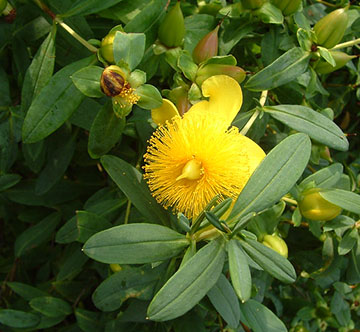 |
Hypericum frondosum 'Sunburst'
This is a popular cultivar of St. John's Wort that features slightly larger flowers (to two inches in diameter) on a more compact plant reaching just 3 feet tall and wide. It is a small, dense, upright, mounded deciduous shrub that is noted for its large showy golden-yellow flowers and attractive blue-green foliage. Blooms in June and July with solitary 5-petaled golden flowers with dense yellow stames that give way to dense reddish-brown capsules that ripen in September. Native from Kentucky to North Carolina south to Georgia, Alabama and Texas where it typically occurs in rocky hills, limestone glades and barrens. Easily grown in average, medium, well-drained soils in full sun to part shade. Tolerant of some drought. Mulch roots in winter. Top growth is not reliably winter hardy in northern climates. Flowers bloom on new wood, so winter damage will not adversely affect flowering. Native. Zone 5 to 8. (3 Gallon container - $36.) |
| Hypericum frondosum 'Sunburst' | |
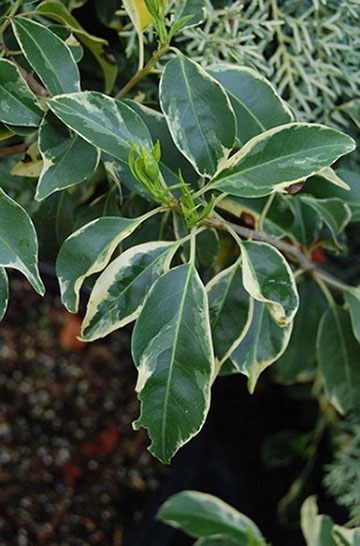 |
Ilex pendunculosa ‘Frosty Morn’, the Variegated Longstalk Holly has foliage that is daringly streaked with creamy-white variegation that looks especially attractive in autumn when set off against cherry-red fruit. Red fruits dangle at the end of long peduncles. Among the hardiest of evergreen hollies. Plant in full sun to partial shade, especially afternoon shade, in average well-drained soil. Reaches fifteen feet tall and wide. Attractive to pollinators. Deer resistant. Zone 5 to 7a. (5 Gallon container - $76.) |
| Ilex pedunculosa 'Frosty Morn' | |
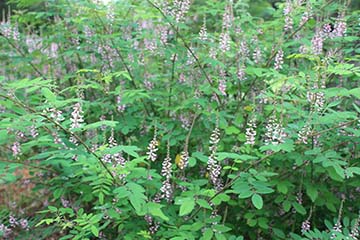 |
|
| Indiogofera ambylantha | |
 |
Indigofera gerardiana (Also known as Indigofera heterantha) is known as Himalayan Indigo. This lovely and unusual shrub, native to dry and sunny slopes in the Himalayas from Afghanistan to China. Clusters of deep, purple-rose colored, pea like flowers from June to fall. They stand out against the delicate grayish green to gray silver colored foliage. Drought tolerant, and will tolerate full sun to part sun. It is a spreading deciduous shrub that reaches a height of eight feet and a width of eight feet. Likes a hard pruning. Has received the Royal Horticultural Society’s Award of Garden Merit. Zone 5 to 8. (3 Gallon container - $54.) |
Indigofera gerardii |
|
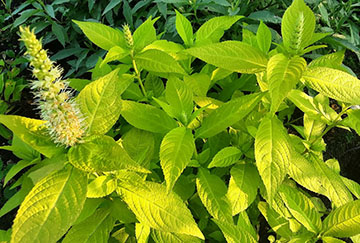 |
Leucosceptrum japonicum 'Gold Angel' is a golden foliaged form of a plant commonly called Japanese shrub mint. It is a woody-based herbaceous perennial that typically forms an attractive foliage mound to 2-3’ tall and as wide. It is native to Japan. Lanceolate to oblong leaves (3-6” long and to 3” wide) are slightly stellate-hairy when young. Tiny yellow flowers (each to 1/3” long) bloom in terminal bottlebrush-like spikes in fall (September-October). Easily grown in organically rich, medium moisture, well-drained soils in part shade to full shade. Best in light shade or morning sun. Leaf scorch will occur in locations with too much sun. Genus name comes from the Greek words leucosmeaning white and skeptron meaning a rod in reference to the hoary plant stems. Zone 5 to 8. (Five pint container - $20.) |
| Leucosceptrum japonicum 'Gold Angel' | |
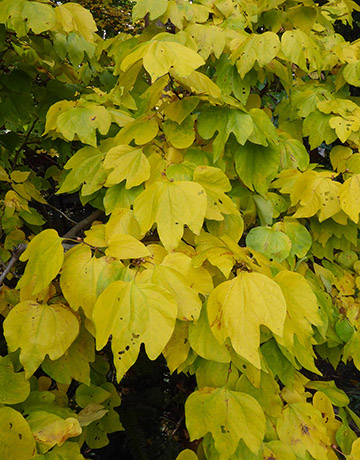 |
Lindera obtusiloba is an underutilized Asian spicebush that develops into a twelve-to-fifteen foot vase-shaped to oval shrub. Cloaked with deep green leaves that have 3 prominent lobes at the terminus. Fall foliage color is vibrant golden yellow hues. Greenish-yellow flowers appear in early spring before the leaves emerge on both male and female plants. In autumn, crops of reddish-black fruit provide added appeal on female plants. Makes an excellent additions to woodland gardens where they show best growth in average garden soils with even moisture. Zone 6 to 9. (Five Pint container - $20.)
|
| Lindera obtusiloba | |
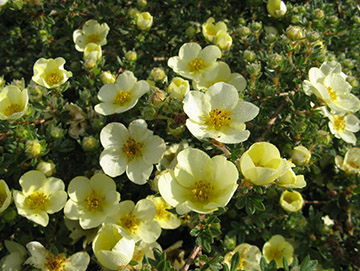 |
Potentilla fruticosa ‘Primrose Beauty’ has beautiful silky, silver-gray foliage and profuse pale-yellow flowers from spring to frost, up to five full months. The flowers look like wild roses and the color mixes well with other plants in the garden. This three foot spreading cinquefoil shrub is a no fuss landscape plant. Easy to grow in most soils, but flowers last longer in moist soil. Plant in full sun to partial shade. Does not need pruning but you can trim lightly in spring to keep neat. Royal Horticultural Society Award of Merit. Zone 4 to 8. (2 Gallon container - $26.) |
| Potentilla fruticosa 'Primrose Beauty' | |
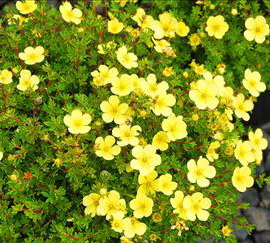 |
Potentilla fruticosa ‘Sundance’ produces bright butter-yellow, double flowers from late spring to frost. Fine grey-green leaves create a compact mounding habit. A tough and very cold hardy deciduous cinquefoil shrub. Vigorous and long lived, reaching two-to-three feet in height and width. Plant in full sun in well drained soil. Tough and adaptable to all conditions. Drought tolerant. Attractive to butterflies. Deer resistant. Zone 3 to 7. (3 Gallon container - $26.) |
| Potentilla fruticosa 'Sundance' | |
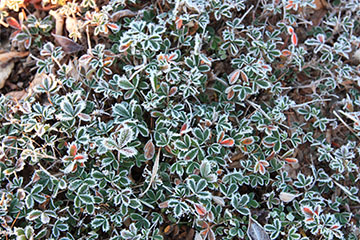 |
Potentilla (Sibbaldiopsis) tridentata or Wine-leaf Cinquefoil is a short evergreen perennial plant growing up to 10 inches tall. Compound, trifoliate leaves grow up to 1 ½” in length and are arranged in an alternate pattern. Leaves are glossy green and evergreen, turning deep red in fall. Flowers are small and white and bloom from June to August. Plant in full sun in well-drained soil. Spreads by underground roots. Drought tolerant. Native to Eastern North America where it grows in rocky and gravelly soil. Zone 5 to 8.
Warren used Wine-leaf Cinquefoil to replace lawns and also an an understory plant in garden troughs. It takes some foot traffic and is very drought tolerant, growing on the rocky soil at the top of Cadillac Mountain in maine. (One Gallon container - $22.)
|
Potentilla tridentata |
|
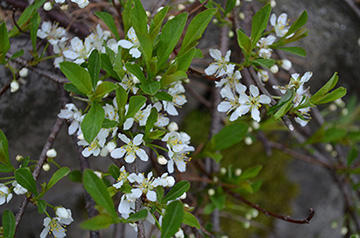 |
Prunus pumila var depressa 'Gus Mehlquist' is an extremely low-growing sprawling sand cherry found along the bank of the Connecticut River in Cheshire County, New Hampshire. Collected and propagated by the Arnold Arboretum, it stands only six-to-twelve inches above the ground, compared to the nine-foot-tall height that a sand cherry shrub can attain. Flowers are dainty with five white petals, followed by blue-black fruits in September. It has elliptic dark green foliage through the growing season, with fall colors displaying brilliant crimson and maroon hues. Performs well in normal garden conditions and displays bolder fall foliage when planted in full sun. It is extremely adaptable to both dry and wet sites. Zone 3 to 6. (Five Pint containers - $20.) |
Prunus pumila var. depressa 'Gus Mehlquist' |
|
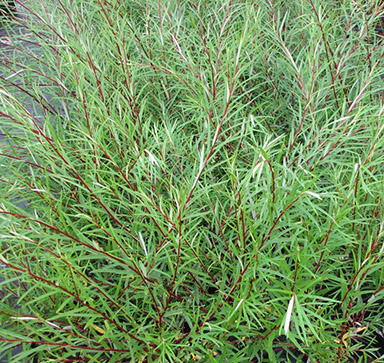 |
Salix elaeagnos, the
Rosemary-Leafed Willow, is an erect bushy deciduous shrub with an overall silvery and airy effect. Narrow grey-green, rosemary-like leaves turn yellow in fall. Reaches a mature height of ten feet tall by sixteen feet wide. Cut back hard to maintain garden size. The bark is smooth and brown in color. Green catkins appear with leaves in the spring. Like all willows, it is dioecious (two sexes). Plant in full sun to light shade. Tolerates wet or dry soils. Our plant originated with Linc Foster, and came as a gift from Joe Eck and Wayne Winterrowd. We have has a Rosemary Willow planted in our parking lot garden for 30 years, with no additional watering.
|
| Salix eleagnos | |
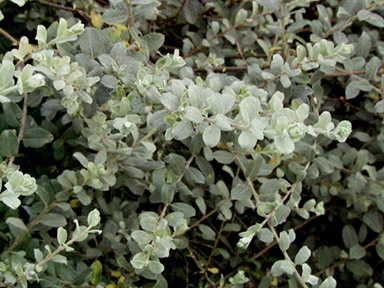 |
Salix repens var. argentea, the Creeping Willow, is a multi-stemmed deciduous shrub with a ground-hugging habit of growth. It is a multi-stemmed, creeping, trailing shrub that spreads to fill in an area, reaching about eighteen inches in height and six feet in width. It lends an extremely fine and delicate texture to the landscape composition, with its attractive grayish green deciduous foliage. The small narrow leaves are highly ornamental, but do not develop any appreciable fall color. The gold stems are very effective and add winter interest. Loads of showy silvery catkins emerge from short internodes all up and down the branches in late winter. They mature to yellow along the bare stems in early spring. Plant in full sun to part shade. Prune in late winter once the threat of extreme cold has passed. Zone 3 to 6. (2 Gallon container - $36.) |
| Salix repens var. argentea | |
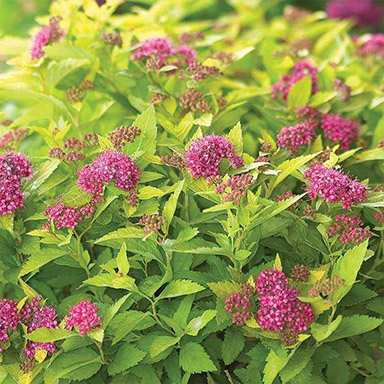 |
Spirea x ‘Mini Gold’ The Mini-Gold Spiraea is a truly compact spiraea that forms rounded mounds fifteen-to-eighteen inches tall and eighteen-to-twenty-four inches wide. The foliage is golden yellow in full sun and chartreuse yellow in part shade. Good fall foliage color. Features numerous pink flowers in flat topped clusters that cover the plant in mid-summer. Plant in full sun in well-drained soil. Tolerates light shade and a wide range of soils. Prune in late winter. A chance cross of Spiraea alpina and Spiraea ‘Goldmound’ at Summer Hill Nursery in Connecticut. Attractive to butterflies and other pollinators. Zone 4 to 8 (2 Gallon container - $24.) |
| Spiraea x japonica 'Mini Gold' | |
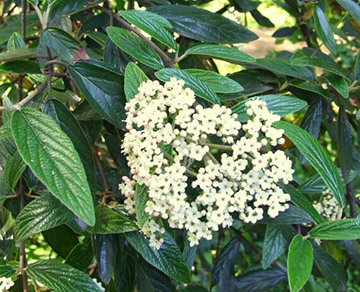 |
Viburnum x ‘Pragense’ This Fragrant Late Blooming Viburnum is an evergreen, multi-stemmed shrub with glossy, dark green leaves, that typically grows eight-to-twelve feet tall and wide. Pink buds open to creamy-white, delicately fragrant flowers in mid to late spring. Showy red berries first appear red and then change to glossy black and persist through December, providing winter interest. Plant in full sun to part shade in average, medium moisture, well drained soil. Foliage may die back in sub-zero temperatures and can also leaf burn. Plant in protected area shielded from winter winds in part shade to full sun to maintain evergreen foliage. Prune, if needed, immediately after flowering. Attractive to birds and butterflies. Hybrid between Viburnum rhytidophyllum and Viburnum utile. Zone 5 to 8. (3 Gallon container - $65.)
|
| Viburnum x ‘Pragense’ | |
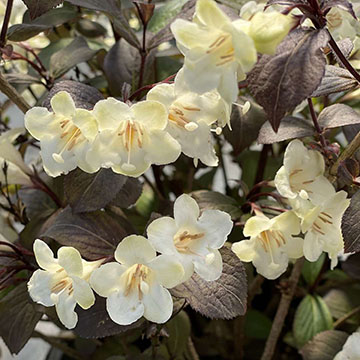 |
Weigela florida ‘Wine & Spirits’ This vigorous, handsome variety of Weigelia combines even more dramatic dark black foliage with crisp white-green flowers, blooming late spring an early summer. A shorter version than ‘Wine and Roses’ with an upright form and uniformly mounding habit to five feet tall and wide. Plant in full sun for best leaf color and blooming. Blooms on old wood. Attractive in a container. Attractive to pollinators. Deer resistant.
Zone 4 to 8. (3 Gallon container - $54.) |
| Weigelia florida 'Wine & Spirits' | |
| VINES AVAILABLE AT THE NURSERY | |
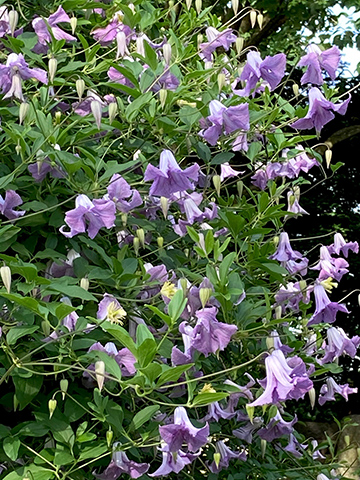 |
Clematis viticella ‘Betty Corning’ is a late, small flowered, semi-woody, climbing vine that typical grows to six feet tall. Features single, nodding, bell-shaped, pale lilac flowers (to two inches long) with recurved tips. Free blooms from summer to fall. Flowers are slightly fragrant. Branches are clad with bipinnate dark green leaves. Plant in part to full sun to part shade in medium moisture soil. Provide mulch and shading to keep roots cool and evenly moist. Prune after blooming. (C. crispa x C. vitcicella) found in Albany NY in 1932. Zone 4 to 9. (2 Gallon container - $48.) |
| Clematis viticella 'Betty Corning' | |
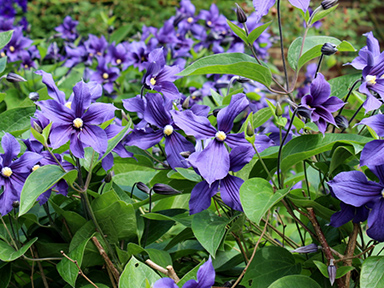 |
Clematis x. durandii - This smaller flowered, non-twining, deciduous vine is known for its long bloom season. Features 4" diameter, bluish-purple flowers with creamy stamens from early summer into fall. 6 to 10 feet tall and 3 to 6 feet wide. Plant in full sun to part shade in fertile, medium moisture, well drained soil. More tolerant to shade then other clematis. Blooms on new growth. Prune to the ground in early spring before new growth appears. A cross between C. Jackmanii and C. Integrifolia, of garden origin. Zone 5 to 9. (2 Gallon container - $48) |
| Clematis x durandii |
|
| FERNS AVAILABLE AT THE NURSERY | |
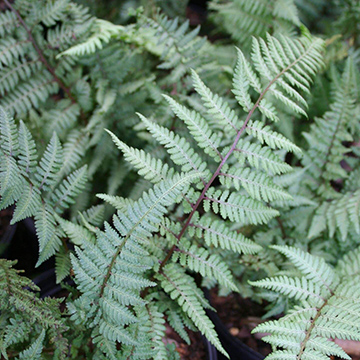 |
Athyrium filix femina x nipponicum ‘Ghost’ - This stunning Lady Fern with silver-white fronds and reddish stems and mid-ribs, has a delicately upright form. Leaves age to light green with new fronds appearing throughout the season. Eighteen to twenty-four inches tall and wide. This fern really prefers shade and moist soil. It will stand up with all fronds perpendicular to the ground in full sun. Spreads by shallow rhizomes to form a ground cover. Cross between A. filix-femina and A. nipponicum from the Virginia garden of Nancy Swell. Zone 3 to 8. ( One Gallon container - $24.) |
| Athyrium filix femina x nipponicum 'Ghost' | |
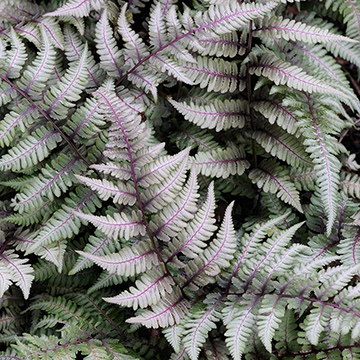 |
Athyrium nipponicum var. pictum - The
Japanese Painted Fern is a deciduous fern with an arching habit that typically grows to eighteen inches tall. Features a slowly spreading clump of triangular, variegated fronds to twenty inches long. Fronds are a soft grayish-green with an overlay of silvery hues accented by contrasting dark maroon midribs. Silvering is best in spring.. Plant in part to full shade in organically rich, medium moisture, well-drained soil. Can form dense colonies, spreading by rhizomes. Zone 3 to 8. (One Gallon container - $15., 2 gallon container - $18) |
| Athyrium nipponicum 'Pictum' | |
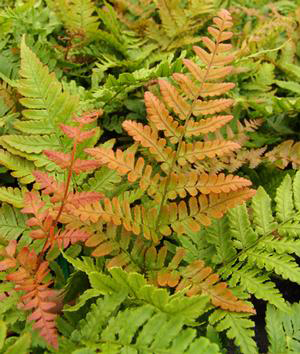 |
Dryopteris erythrosora ‘Brilliance’ - In spring, new fronds on this Autumn Fern unfurl in striking shades of orange-red to copper-pink before eventually maturing to glossy green. Red color returns in fall. Arching (semi-evergreen) fern grows in a vase-shaped clump to two feet tall and wide. Young sori and covered in bring red. Plant in part to full shade in medium to wet soils that are slightly acidic. Spread over time. Protect from winter winds. Native to woodland hillsides in Japan and China. Zone 5 - 8 (One Gallon container - $18.) |
| Dryopteris erythrosora 'Brilliance' | |
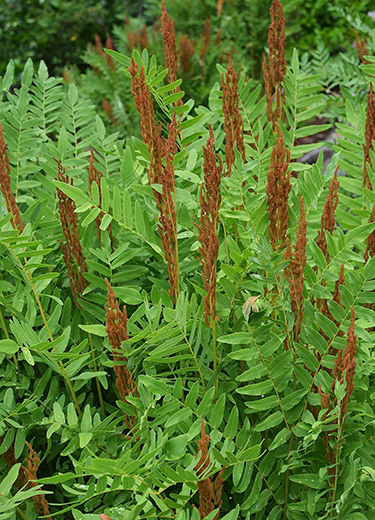 |
Osmunda regalis, the
Royal Fern is a tall deciduous, native fern that occurs on moist bluffs and edges and along streams, sometimes growing in the water. Typically grows in two-to-three feet tall clumps, but with constant moisture can reach 6 feet in height. Broad fronds have large, well separated fronds, giving a pea-like appearance. Fronds turn yellow ib autumn. Prefers moist, rich, humusy, acidic soils but adapts to lesser conditions. Part shade to full sun. Tolerates heavy shade and wet soils. Zone 3 to 9. (One Gallon container - $18.) |
| Osmunda regalis |
|
| GRASSES AVAILABLE AT THE NURSERY | |
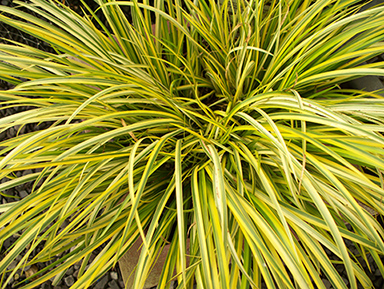 |
Acorus gramineus 'Ogon' is a dwarf variety of grassy-leaved sweet flag, which features iris-like tufts of narrow, grass-like, variegated leaf blades (six to twelve inches tall and 1/4" wide) that fan outward. Leaves are striped with yellow and green but primarily appear as yellow. It is a semi-evergreen, marginal aquatic perennial. The foliage is sweetly fragrant when bruised. Tiny, insignificant, yellow-green flowers bloom from spring to early summer on lateral, sedge-like flower spikes. Flowers give way to very tiny, reddish, fleshy berries. Tufts will slowly spread over time by rhizomes to form a dense ground cover. Plants thrive in wet soils and are commonly grown in water gardens and boggy areas for foliage accent or ground cover purposes. Native to wetland areas of southern Asia. When placed in a water garden, the roots of this plant give off a compound that kills mosquito larvae. Zone 5 to 9. (One gallon containers - $18.) |
| Acorus gramineus 'Ogon' | |
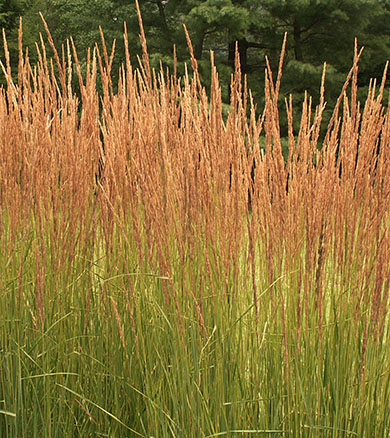 |
Calamagrostis x acutiflora‘Karl Foerster’ - This Feather Reed Grass is noted for its clumps of narrow-vertical growth of bright green leaves to three feet tall and two feet wide. Feathery plumes of summer blooming pink-to-purple tinged flowers on narrow upright stalks well above foliage to five feet. Flowers are followed by golden seeds which mature to tan. Plant in full sun in average, medium to wet soil. Prefers rich, consistently moist soil that does not dry out. Cut clumps to ground in late winter before new shoots appear. Winter Interest. Attractive to birds. Zone 5 to 9 (One Gallon container - $18.) |
| Calamagrostis x acutiflora 'Karl Foerster' | |
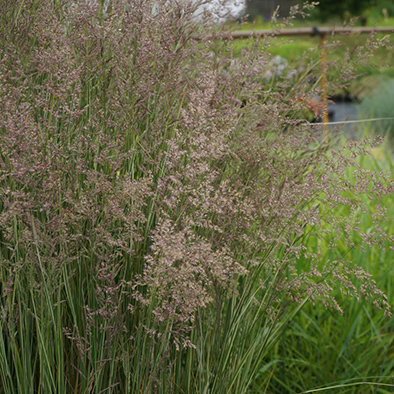 |
Calamagrostis x acutiflora ‘Overdam’ - This Feather Reed Grass is noted for its dense, erect clumps of narrow variegated foliage, featuring green leaves with creamy white margins. More compact size reaching just two-to-four in height. Topped by upright, pinkish white flower plumes in summer. Flowers are followed by golden seeds which mature to tan. Plant in full sun to light shade in average, medium to wet soils. Prefers rich consistently moist soils that do not dry out. Cut to ground in late winter before new shoots appear. Zone 4 to 8 (One Gallon container - $18.) |
| Calamagrostis x acutiflora 'Overdam | |
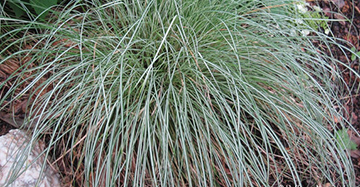 |
|
| Carex morowii var. temnolepsis | |
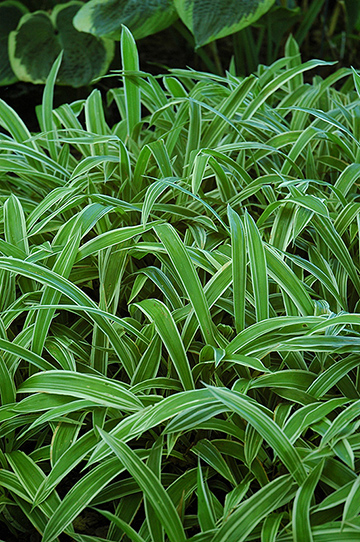 |
Carex siderosticta 'Variegata' is a deciduous perennial grass with green, variegated and white foliage. Features grassy texture. Unusually broad leaf width (blades are sometimes described as bamboo-like) gives rise to the often-used common name of broad-leaved sedge. Insignificant brownish flower spikes appear on triangular stems in late spring. Easily grown in medium to wet soils in part shade to full shade. Cut foliage to the ground and remove in late winter. May be propagated by division. Plants will spread over time by rhizomes to form a dense ground cover.Native to woodland mountain areas in China, Japan and Korea. Zone 5 to 9. (Five-pint containers - $18.) |
| Carex siderostricta 'Variegata' | |
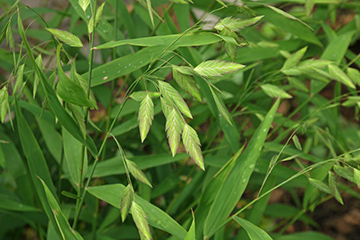 |
Chasmanthium latifolium, known as Northen sea Oats, is a clump-forming, upright, ornamental grass. Distinguished by the flat, drooping seed heads which hang in terminal clusters on thread-like pedicils from slightly arching stems. Seed heads will flutter when caressed by even the softest of breezes. Seed heads emerge green but turn purplish bronze by late summer. Bright green leaves (five to nine inches long) turn a coppery color after frost and eventually brown by winter. Excellent for dried flower arrangements. Common name of inland sea oats is in reference to the similarity of the seed heads to those of oats. Easily grown in average, medium to wet, well-drained soil in full sun to part shade. Tolerant of poor soils, but prefers moist, fertile soils. One of the more shade tolerant of the ornamental grasses. Self-seeds and may spread aggressively. Leaving foliage in place over winter adds interest to the landscape and helps protect crowns from the cold. Cut back to the ground in early spring. Native to rich woods or rocky slopes along streams and on moist bluffs in the midwest. Zone 3 to 8. (Five-pint container - $12.50) |
| Chasmanthium latifolium | |
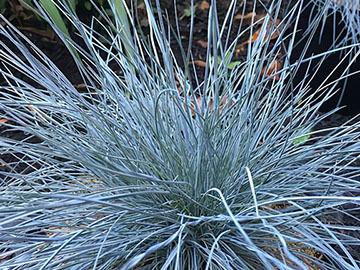 |
Festuca glauca ‘Beyond Blue’ - Blue fescue is valued for its clumping habit, and display of colorful, grassy foliage. This selection forms a dense tuft of slender cascading foliage that is intensely silver-blue all season. None to twelve inches tall and sixteen-to-eighteen inches wide. Light green flowers with a purple tinge appear in terminal panicles atop stems that rise above the foliage in late spring to early summer. Flowers give way to buff-colored seed heads. Impressively tolerant to cold, heat, humidity, low water, deer and poor soil conditions. Excellent for mass planting, edging or in the rock garden. Plant in full sun in well drained soil. Zone 4 to 9. (Five pint containers - $15.) |
| Festuca glauca 'Beyond Blue | |
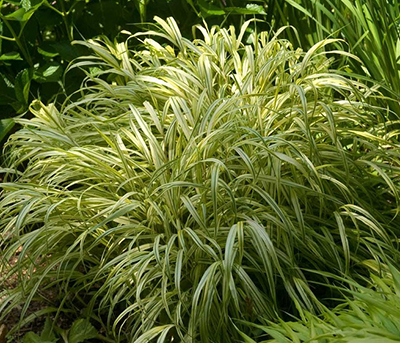 |
Hakonechloa macra ‘Aureola’ - This beautiful Japanes Forest Grass has gold foliage that forms attractive mounds of gracefully arching, shiny leaves that ripple in the slightest breeze. Leaves are almost entirely variegated with gold longitudinal stripes that take chartreuse colors in the shade and turn brighter in the sun. Copper to orange fall color before dying to the ground. One-to-two feet tall and wide. Plant in full sun to partial shade in medium, well-drained garden soil. Zone 5 to 9 (One Gallon container - $30.) |
| Hakonenechloa macra 'Aureola' | |
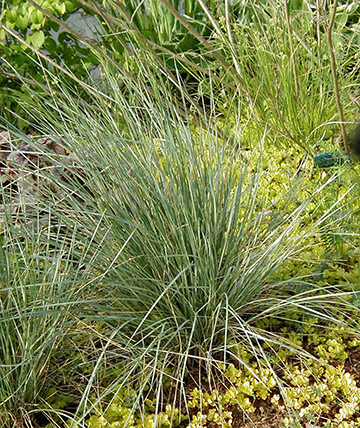 |
Helictotrichon sempervirens ‘Sapphire’ - The foliage on this
Blue Oat Grass typically grows to eighteen inches tall with flower spike rising above the foliage to twenty-four-to-thirty-six inches. Slightly wider leaf blade than the species and better steel-blue color. Forms a porcupine like clump, resembling blue fescue but is significantly larger. It is also more rust resistant and has better tolerance to heat and humidity than the species. Plant in full sun in average garden soil that is dry to medium moisture. Cut back in winter. Zone 4 to 8. (Five pint container - $15.) |
| Helictotrichon sempervirens 'Sapphire' | |
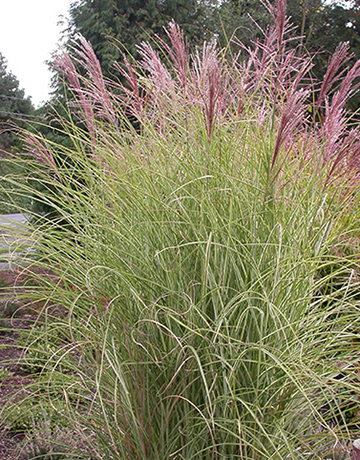 |
Miscanthus sinensis 'Morning Light' is a eulalia grass cultivar that is noted for its very narrow green leaves with white variegation on the margins. Foliage has an overall silvery appearance. Typically forms an upright, rounded clump of foliage growing four to six feet' tall. Tiny reddish-copper flowers appear in long tassel-like inflorescences above the foliage in mid-to-late September, gradually turning into silvery white plumes as the seeds mature. Blooms later than most Miscanthus cultivars. Flower plumes persist well into winter providing good winter interest. Easily grown in average, medium moisture, well-drained soil in full sun to part shade. Tolerant of a wide range of soils from well-drained sandy soils to the heavy clays. Best in full sun. Less vigorous with decreased flowering and tendency to flop in too much shade. Tolerant of summer heat and humidity. Clumps slowly expand in circumference by short rhizomes, but typically retain tight clump shape. Foliage should be left standing throughout the winter for visual interest and crown protection. Cut foliage close to the ground in late winter just before new shoots appear. Propagate by division of the crown. Zone 5 to 9. (3 Gallon container - $42.) |
| Miscanthus sinensis 'Morning Light' | |
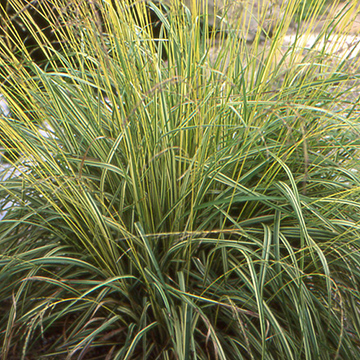 |
Molinia caerulea 'Variegata’ is a compact, clump-forming purple moor grass cultivar that, as the cultivar name suggests, features variegated leaf blades (to 3/8” wide and to eighteen inches long) with creamy yellow and green longitudinal stripes. Mature plants produce profuse numbers of erect to slightly arching mid-summer flowering stalks which rise above the foliage to twenty-four-to-thirty inches tall. Each stalk being topped by a panicle (to five-to-ten inches long) of yellow-tan-purple flowers. Flower stalks have a certain transparent see-through quality. As seed sets, the flower panicles turn an attractive yellow-tan. Variegated foliage also turns yellow in fall. Easily grown in average, medium to wet, well-drained soil in full sun. Tolerates light shade, particularly, but is generally less vigorous with decreased flowering in too much shade. Unlike many of the ornamental grasses, the foliage and flower stalks of purple moor grass typically break down and fall over in late fall, providing little winter interest. Cut any surviving foliage back to the ground in early spring (late February-March) just before the new leaf blades appear. This is a slow-growing grass. Zone 4 to 9. (One Gallon container - $18.) |
| Molinia caerulea 'Variegata' | |


